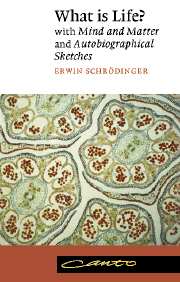Book contents
- Frontmatter
- Contents
- WHAT IS LIFE?
- Foreword
- Preface
- 1 THE CLASSICAL PHYSICIST'S APPROACH TO THE SUBJECT
- 2 THE HEREDITARY MECHANISM
- 3 MUTATIONS
- 4 THE QUANTUM-MECHANICAL EVIDENCE
- 5 DELBRÜCK'S MODEL DISCUSSED AND TESTED
- 6 ORDER, DISORDER AND ENTROPY
- 7 IS LIFE BASED ON THE LAWS OF PHYSICS?
- EPILOGUE. ON DETERMINISM AND FREE WILL
- MIND AND MATTER
- 1 THE PHYSICAL BASIS OF CONSCIOUSNESS
- 2 THE FUTURE OF UNDERSTANDING
- 3 THE PRINCIPLE OF OBJEGTIVATION
- 4 THE ARITHMETICAL PARADOX: THE ONENESS OF MIND
- 5 SCIENCE AND RELIGION
- 6 THE MYSTERY OF THE SENSUAL QUALITIES
- AUTOBIOGRAPHICAL SKETCHES
Foreword
Published online by Cambridge University Press: 05 June 2013
- Frontmatter
- Contents
- WHAT IS LIFE?
- Foreword
- Preface
- 1 THE CLASSICAL PHYSICIST'S APPROACH TO THE SUBJECT
- 2 THE HEREDITARY MECHANISM
- 3 MUTATIONS
- 4 THE QUANTUM-MECHANICAL EVIDENCE
- 5 DELBRÜCK'S MODEL DISCUSSED AND TESTED
- 6 ORDER, DISORDER AND ENTROPY
- 7 IS LIFE BASED ON THE LAWS OF PHYSICS?
- EPILOGUE. ON DETERMINISM AND FREE WILL
- MIND AND MATTER
- 1 THE PHYSICAL BASIS OF CONSCIOUSNESS
- 2 THE FUTURE OF UNDERSTANDING
- 3 THE PRINCIPLE OF OBJEGTIVATION
- 4 THE ARITHMETICAL PARADOX: THE ONENESS OF MIND
- 5 SCIENCE AND RELIGION
- 6 THE MYSTERY OF THE SENSUAL QUALITIES
- AUTOBIOGRAPHICAL SKETCHES
Summary
When I was a young mathematics student in the early 1950s I did not read a great deal, but what I did read - at least if I completed the book — was usually by Erwin Schrödinger. I always found his writing to be compelling, and there was an excitement of discovery, with the prospect of gaining some genuinely new understanding about this mysterious world in which we live. None of his writings possesses more of this quality than his short classic What is Life? — which, as I now realize, must surely rank among the most influential of scientific writings in this century. It represents a powerful attempt to comprehend some of the genuine mysteries of life, made by a physicist whose own deep insights had done so much to change the way in which we understand what the world is made of. The book's cross-disciplinary sweep was unusual for its time — yet it is written with an endearing, if perhaps disarming, modesty, at a level that makes it accessible to non-specialists and to the young who might aspire to be scientists. Indeed, many scientists who have made fundamental contributions in biology, such as J. B. S. Haldane and Francis Crick, have admitted to being strongly influenced by (although not always in complete agreement with) the broad-ranging ideas put forward here by this highly original and profoundly thoughtful physicist.
- Type
- Chapter
- Information
- What is Life?With Mind and Matter and Autobiographical Sketches, pp. xPublisher: Cambridge University PressPrint publication year: 1992

